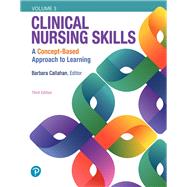For courses in concept-based nursing.
#1 curriculum choice for concept-based schools of nursing
Nursing: A Concept-Based Approach to Learning provides all of the core content and materials needed to deliver an effective concept-based program that develops practice-ready nurses. This three-volume series is the only concepts curriculum developed from the ground up as a cohesive, comprehensive learning system. An intentional instructional design and learning pattern fosters connections between concepts and a deep level of comprehension that can be applied broadly. Volume III, Clinical Skills: A Concept-Based Approach, presents more than 275 key nursing skills, with 250 minor skills embedded within them, that complement concepts in the first two volumes and support a concept-based approach. The 3rd edition of Volume III is a full-scale, cover-to-cover revision that brings the text in line with new evidence-based practice, care, and safety guidelines.










